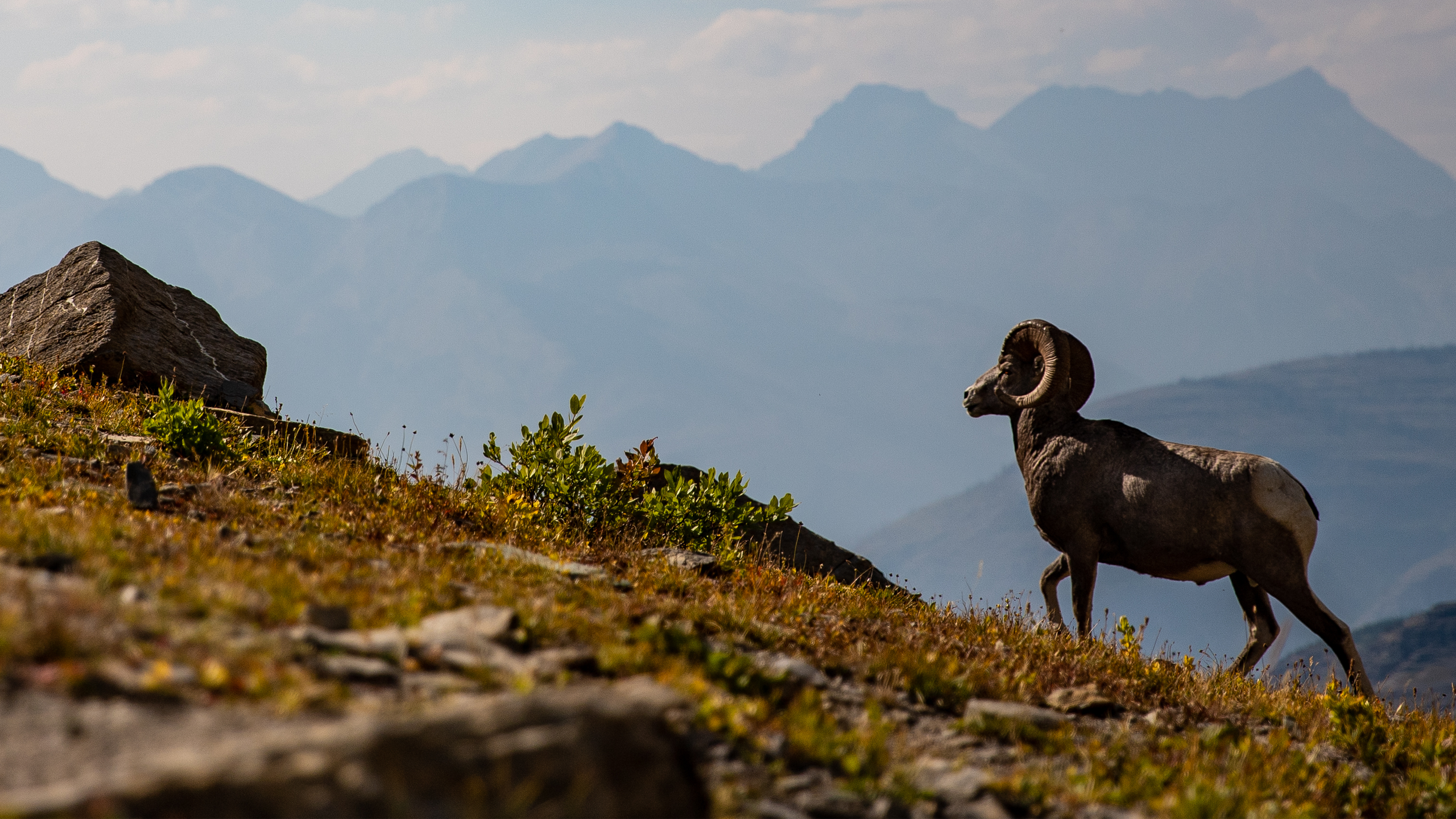Posted: March 13, 2022
Our Wildlife of the Week – 2022 Week 10…
Meet the “Bighorn Sheep”!
(Ovis canadensis)
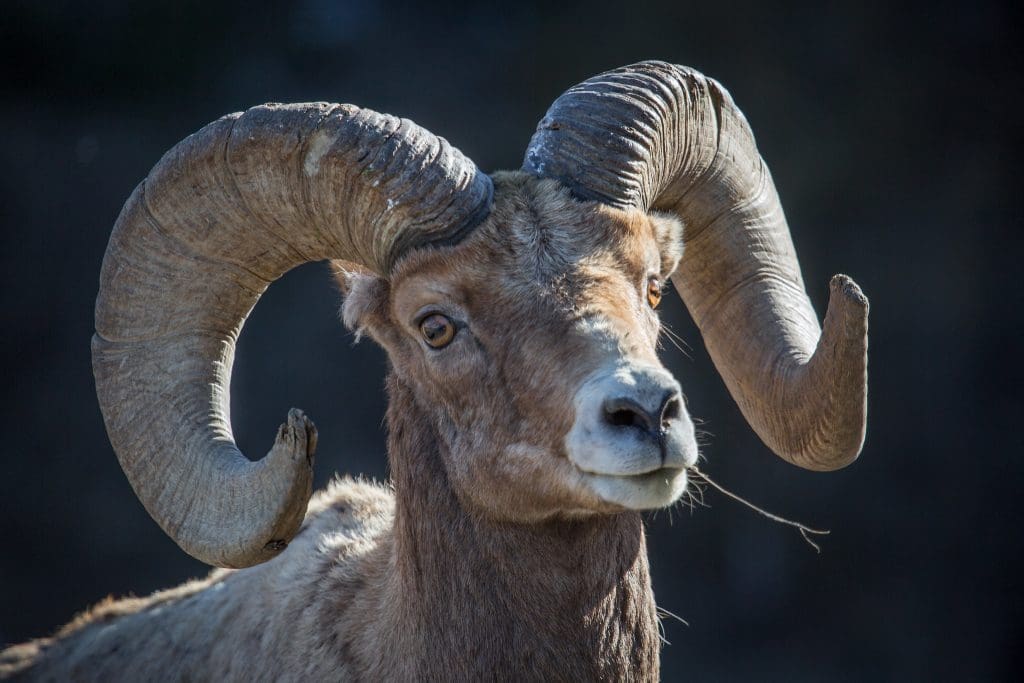
Bighorn Sheep Physical Description
Males weigh approximately 262-280lbs (119-127kg) and females weigh approximately 117-201lbs (53-91kg). Rams typically measure 5ft 3in-5ft 11in (160-180cm) from head to tail, while ewes (a female sheep) are approximately 4ft 11in (150 cm).1
Bighorn sheep have double-layered skulls shored with struts of bone for battle protection. They also have a broad, massive tendon linking skull and spine to help the head pivot and recoil from blows. Horns may way as much as 31lbs (14kg), which is the weight of all the bones in a ram’s body.1
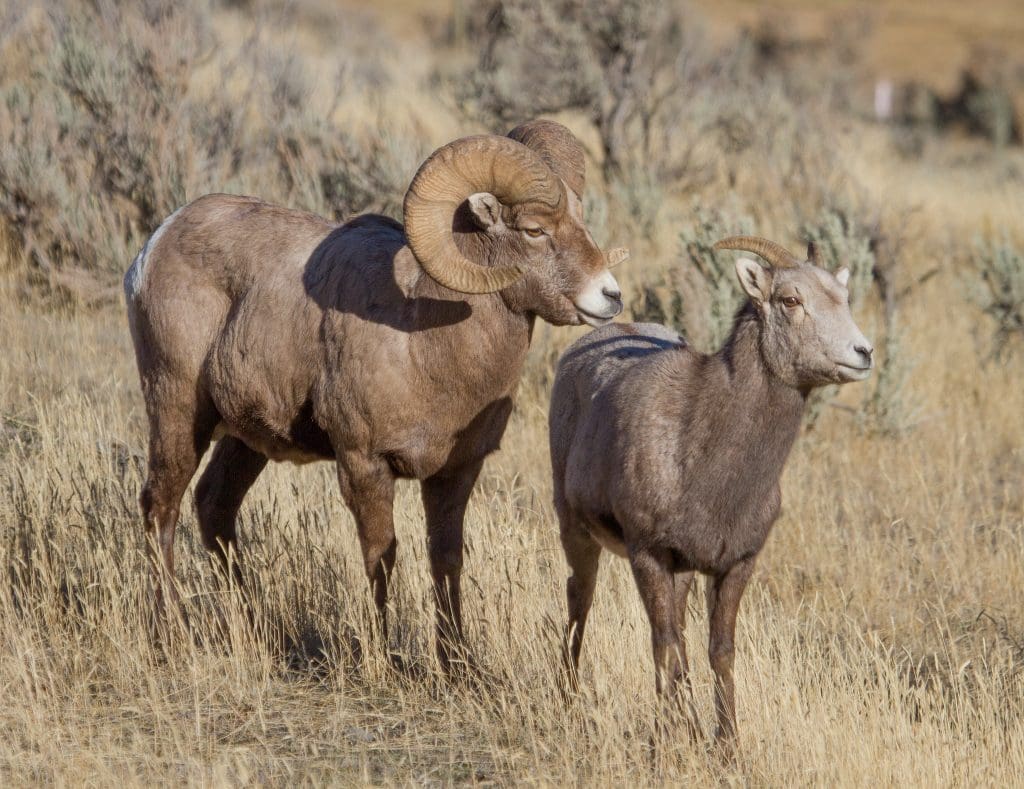
The horns of a female are much smaller and only slightly curved. The horns of a ram can tell much about him such as his age, health, and fighting history.1
The pelage (fur, hair, or wool of a mammal) is smooth and composed of an outer coat of brittle guard hairs and short, grey, crimped fleece underfur. The summer coat is a rich, glossy brown but it becomes quite faded by late winter.1
SPONSORED ADVERTISEMENT
Bighorn Sheep In Action
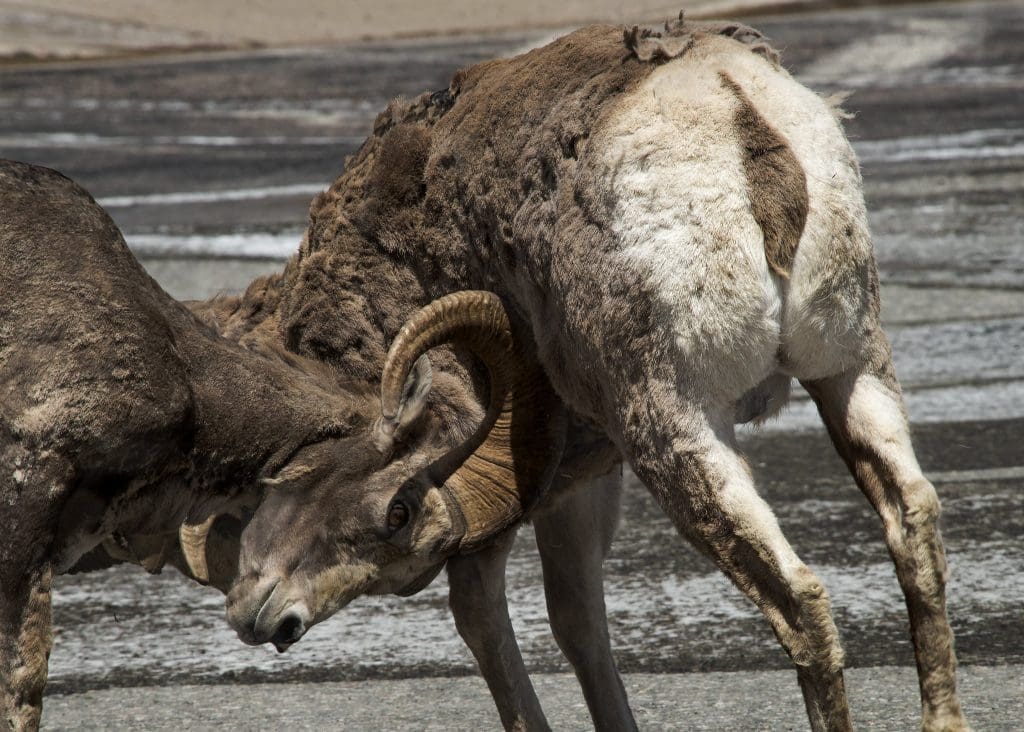
Although not as well built for climbing as mountain goats, bighorn sheep zigzag up and down cliff faces with amazing ease. They use ledges only 2 inches wide for footholds, and bounce from ledge to ledge over spans as wide as 20 feet. They can move over level ground at 30 miles per hour and scramble up mountain slopes at 15 mph. They also swim freely, despite their massive bulk and the weight of their horns.1
Most populations undergo seasonal movements, generally using larger upland areas in the summer and concentrating in sheltered valleys during the winter.1
Bighorn sheep are gregarious (living in flocks or loosely organized communities), sometimes gathering in herds of over 100 individuals, although small groups of 8 to 10 are more common. Mature males usually stay apart from females and young for most of the year in separate bachelor flocks. Young females generally remain in their mother’s group (led by an older ewe), but males depart when two to four years old and join a group of rams. Young sheep of both sexes learn migratory paths and suitable habitats from adults in the group.1
SPONSORED ADVERTISEMENT
Where to Spot Bighorn Sheep
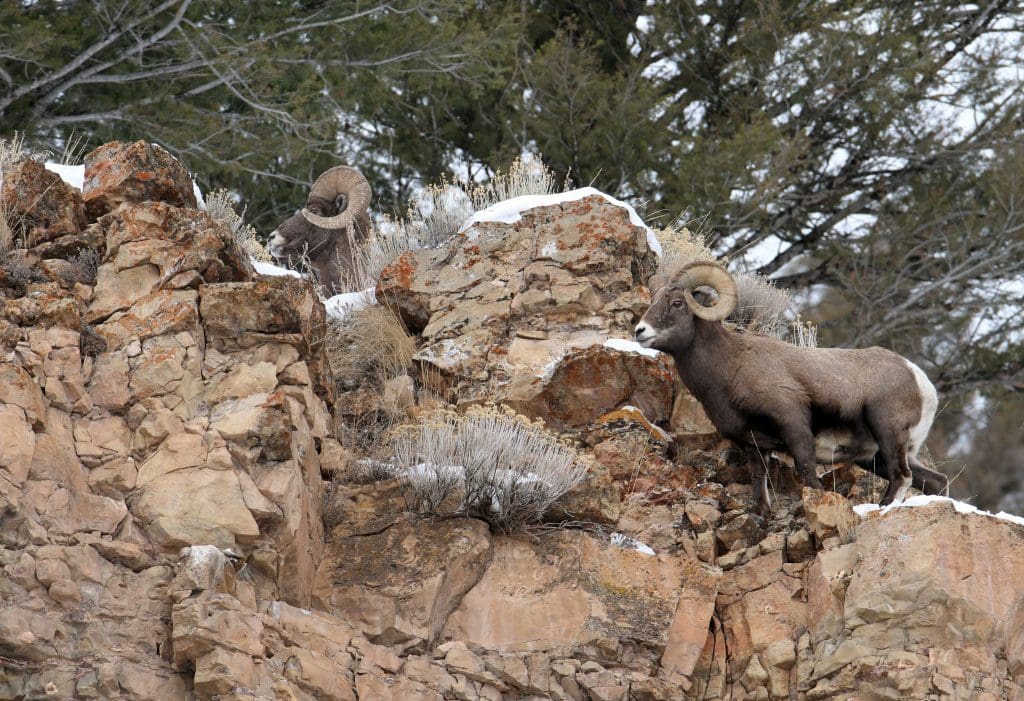
Bighorn sheep inhabit alpine meadows, grassy mountain slopes and foothill country in proximity to rugged, rocky cliffs and bluffs. Bighorn sheep require drier slopes where the annual snowfall is less than about sixty inches a year, since they cannot paw through deep snow to feed. The winter range usually lies between 2,500-5,000 feet in elevation, while the summer range is between 6,000-8,500 feet.1
The Bighorn Sheep can be found in over 20 National Parks and many other National Park Service sites.2 Including:
- Arches National Park
- Badlands National Park
- Big Bend National Park
- Black Canyon of the Gunnison National Park
- Bryce Canyon National Park
- Canyonlands National Park
- Capital Reef National Park
- Death Valley National Park
- Glacier National Park
- Grand Canyon National Park
- Grand Teton National Park
- Great Basin National Park
- Great Sand Dunes National Park and Preserve
- Joshua Tree National Park
- North Cascades National Park
- Rocky Mountain National Park
- Sequoia & Kings Canyon National Parks
- Theodore Roosevelt National Park
- Yellowstone National Park
- Zion National Park
SPONSORED ADVERTISEMENT
Bighorn Sheep Conservation Status
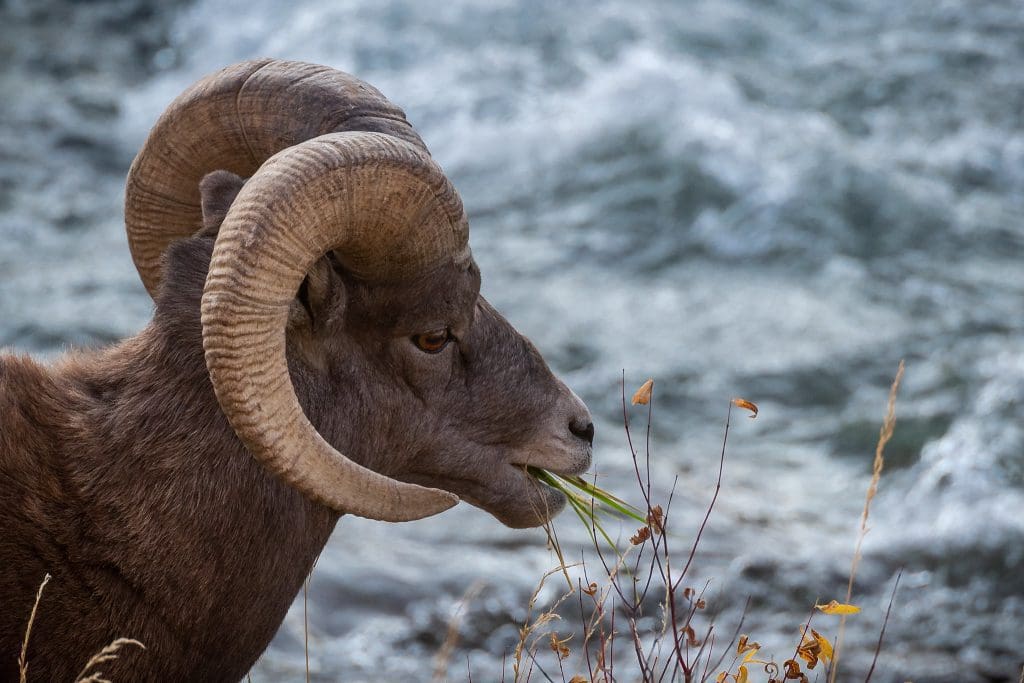
Native Americans and early settlers prized bighorn meat as the most palatable of American big-game species. Native Americans also used the horns to fashion large ceremonial spoons and handles for utensils. The horns have also been popular for many centuries as trophies. Bighorn sheep may serve as an attraction for ecotourism ventures in parts of western North America.1
Several populations may be threatened with eventual extinction, bighorn numbers are only one-tenth the population that existed when western settlers first began exploiting the Rockies. Their main threats are unregulated or illegal hunting, introduced diseases, competition from livestock, and continual human encroachment on their habitat.1
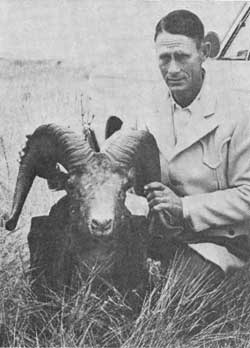
Before the year 1900, a subspecies known as Audubon’s bighorn sheep (ovis canadensis auduboni) roamed parts of western Nebraska, including the Pine Ridge of the northwestern part of the state and the Wildcat Hills in the area near Scotts Bluff.3
In fact, emigrant James Tolles wrote in the trail journal of his 1849 journey that “(Scotts Bluff) is near 600 ft in height; and we had much difficulty in ascending it, but was well repaid for our trouble, upon this rock we found pine trees, grass, and some very nice flowers. We saw upon this bluff over 50 mountain sheep.” Unfortunately, the Audubon’s subspecies of bighorns was likely reduced to extinction in the early 1900s due to disease, habitat loss and hunting.3
Bighorn sheep are incompatible with domestic sheep because they are susceptible to diseases of domestic livestock, including pneumonia, which is periodically responsible for large die-offs in bighorn sheep populations.1
Hunting has been prohibited or controlled since the early 1900’s, but much illegal poaching still occurs. Hunting for trophies is particularly damaging to the cohesiveness of bighorn groups because it eliminates the dominant, breeding males. Recovery of numbers has been slow for these animals and their future is threatened unless further conservation measures are implemented. California bighorn sheep (ovis canadensis californicus) are considered endangered under the U.S. Endangered Species Act.1
Bighorn Sheep and You
Have you seen a Bighorn Sheep in it’s natural environment? Tell us about it in the comments below!
Do you have a picture of these amazing little creatures? Share it on social media with us and tag us in your post.
Use the hashtag:
#WildlifeOfTheWeek.
Interested in Wildlife Photography???
Check out this amazing beginners guide from National Geographic:
National Geographic Photo Basics The Ultimate Beginner’s Guide to Great Photography
The above links are provided in this article as affiliate links. Meaning, at no additional cost to you, we’ll earn a commission if you click one and make a purchase. An easy way to help support us if you’re going to buy anyway!
Learn more about all the amazing wildlife in our National Parks and how to safely “Watch Wildlife” on this amazing page with lots of resources from the National Park Service!
Want tips for photographing wildlife? Check out this great article for tips from the National Park Service.
Help support Discover Our Parks by becoming a Patron for as little as $1 a month! Your support will help us continue to provide articles like this and add even more information about our parks to this site.
If you want to make a one-time donation, buy us a coffee!
‘We got some of the above information from the following:
1: Animal Diversity Web – Ovis Canadensis – Bighorn Sheep
2: NPSpecies – Find Parks Where a Species is Found
3: NPS – Bighorn Sheep in Nebraska
Check out these recent posts from Discover Our Parks:
- The Isolated Black-bellied Salamander: Wildlife of the Week – 2023 Week 22
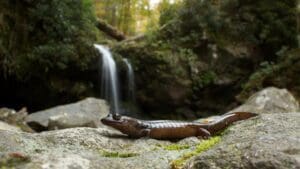
- The Splendid Sandhill Crane: Wildlife of the Week – 2023 Week 21
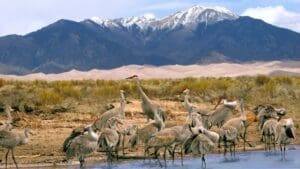
- The Promising Peregrine Falcon: Wildlife of the Week – 2023 Week 20
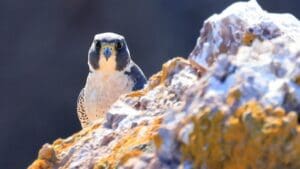
- The Intimidating Killer Whale: Wildlife of the Week – 2023 Week 19

- The Swift Fox: Wildlife of the Week – 2023 Week 18
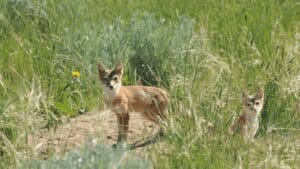
SPONSORED ADVERTISEMENT

